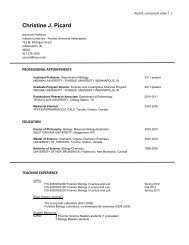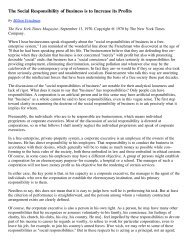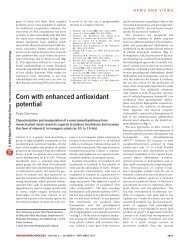Blazer-Yost, B.L. - Biology @ IUPUI
Blazer-Yost, B.L. - Biology @ IUPUI
Blazer-Yost, B.L. - Biology @ IUPUI
Create successful ePaper yourself
Turn your PDF publications into a flip-book with our unique Google optimized e-Paper software.
Hindawi Publishing Corporation<br />
PPAR Research<br />
Volume 2010, Article ID 785369, 5 pages<br />
doi:10.1155/2010/785369<br />
Review Article<br />
PPARγ Agonists: Blood Pressure and Edema<br />
Bonnie L. <strong>Blazer</strong>-<strong>Yost</strong><br />
Department of <strong>Biology</strong>, Indiana University-Purdue University Indianapolis, 723 West Michigan Street, SL 358 Indianapolis, IN 46202,<br />
USA<br />
Correspondence should be addressed to Bonnie L. <strong>Blazer</strong>-<strong>Yost</strong>, bblazer@iupui.edu<br />
Received 26 August 2009; Accepted 23 November 2009<br />
Academic Editor: Tianxin Yang<br />
Copyright © 2010 Bonnie L. <strong>Blazer</strong>-<strong>Yost</strong>. This is an open access article distributed under the Creative Commons Attribution<br />
License, which permits unrestricted use, distribution, and reproduction in any medium, provided the original work is properly<br />
cited.<br />
Peroxisome proliferator activated receptor γ(PPARγ) agonists are widely used in the treatment of type 2 diabetes. Side effects of<br />
drug treatment include both fluid retention and a lowering of blood pressure. Data from animal and human studies suggest that<br />
these effects arise, at least in part, from drug-induced changes in the kidney. In order to capitalize on the positive aspect (lowering of<br />
blood pressure) and exclude the negative one (fluid retention), it is necessary to understand the mechanisms of action underlying<br />
each of the effects. When interpreted with known physiological principles, current hypotheses regarding potential mechanisms<br />
produce enigmas that are difficult to resolve. This paper is a summary of the current understanding of PPARγ agonist effects on<br />
both blood pressure and fluid retention from a renal perspective and concludes with the newest studies that suggest alternative<br />
pathways within the kidney that could contribute to the observed drug-induced effects.<br />
1. Introduction<br />
PPARγ agonists, also called thiazolidinediones (TZDs), are<br />
widely used as insulin-sensitizing agents in the treatment of<br />
type 2 diabetes. One unanticipated, and poorly understood,<br />
side effect of the TZDs is a lowering of blood pressure.<br />
In the vast majority of patients treated with these drugs,<br />
the change in blood pressure per se can be viewed as<br />
a positive consequence of drug therapy. Statistically the<br />
classic type 2 diabetic patient has increased blood pressure<br />
that is treated by pharmaceutical intervention. Indeed, this<br />
beneficial property as well as positive effects on lipid profiles<br />
and inflammatory responses has prompted the suggestion<br />
that this class of drugs might be useful in treating metabolic<br />
syndrome, a prediabetic state that is reaching epidemic<br />
proportions in industrialized societies [1, 2].<br />
However, treatment with PPARγ agonists is not without<br />
negative side effects. Particularly noteworthy when considering<br />
using TZDs to treat overweight or obese patients<br />
is the propensity for these drugs to cause weight gain.<br />
The weight gain is multifactorial and includes a positive<br />
effect on adipogenesis [3] and a diuretic-resistant fluid<br />
retention [4, 5]. As with the effect on blood pressure, the<br />
physiological mechanisms responsible for fluid retention are<br />
poorly understood.<br />
This paper examines the positive (lowering of blood<br />
pressure) and the negative (fluid retention) side effects of<br />
TZD treatment from a renal perspective. An important consideration<br />
for the development of drugs to treat metabolic<br />
syndrome is the question of whether the beneficial side effect<br />
can be dissociated from the negative action. Unfortunately,<br />
at this point one can only outline the issues—the answers<br />
await further experimentation to elucidate the mechanisms<br />
of action involved in these side effects.<br />
2. Fluid Retention<br />
The PPARγ agonist-induced fluid retention results in plasma<br />
volume expansion (often measured as a decrease in hematocrit)<br />
and peripheral edema [5]. The excess fluid retention<br />
is relatively resistant to diuretics [4, 5]. In a diuretic<br />
comparison study, the most promising results were obtained<br />
with intensive therapy using an aldosterone antagonist that<br />
has actions in the distal tubule/collecting duct [6].
2 PPAR Research<br />
The propensity to cause fluid retention is serious enough<br />
to raise questions about the continued use of these agonists—<br />
particularly in a marginal patient population. Rat studies<br />
have indicated that the increased plasma volume can cause<br />
relatively rapid cardiac remodeling, even in healthy animals<br />
[7]. A recent high-profile meta-analysis has indicated that<br />
Avandia (rosiglitazone) increases the risk of death from<br />
cardiovascular disease [8], while other studies have observed<br />
beneficial effects of TZDs on major cardiovascular events in<br />
humans as well as protection against ischemia-reperfusion<br />
injury and reduction of myocardial infarct size in animal<br />
models [9–11]. Additional data are required to ascertain<br />
the risk/benefit relationships of TZD therapy for patients<br />
with cardiovascular risk factors but it is clear that edema<br />
is an undesirable side effect. Effective therapy to limit fluid<br />
retention would increase the usefulness of this class of<br />
compounds and is necessary if they are to be used as a<br />
prophylactic treatment to delay the progression of metabolic<br />
syndrome to type 2 diabetes.<br />
3. Blood Pressure<br />
Modest decreases in blood pressure during treatment with<br />
PPARγ agonists are a consistent finding in studies conducted<br />
in normal, diabetic, and hypertension-prone rodents and<br />
humans (see [1]). The effect, when measured continuously<br />
in rodents, is rapid and usually manifested within 12–24<br />
hours of the initial dosing [7, 12]. Is this a secondary<br />
side effect of the drugs per se or does this observation<br />
indicate that the receptor is important in maintaining a<br />
normal blood pressure? An experiment of nature indicates<br />
the latter. Barroso et al. characterized rare dominant negative<br />
mutations in the human peroxisome proliferator activated<br />
receptor γ. As expected, these patients have insulin resistance<br />
and diabetes mellitus. Interestingly, the patients also have<br />
severe hypertension that is difficult to control [13]. Thus, the<br />
data indicate that loss of the receptor leads to severe increases<br />
in blood pressure and activation of the receptor as seen in<br />
PPARγ agonist therapy causes a decrease in blood pressure.<br />
4. Site of Action<br />
There is general consensus that the change in blood pressure<br />
is likely due to a combination of renal and vascular effects.<br />
This contention is underlined by the observations that TZDs<br />
simultaneously increase fluid retention and decrease blood<br />
pressure. Assuming normal cardiac function, it is hard to<br />
imagine a scenerio where plasma volume expansion leads to<br />
a decrease in blood pressure without a substantial change in<br />
the vasculature.<br />
PPARγ regulation in the vasculature is complex and may<br />
exert actions on both endothelial and smooth muscle cell<br />
function. Effects on the multiple parameters of vascular<br />
function have been recently elucidated using vascular celltype-specific<br />
PPARγ knockout mice. Animals defective in<br />
the endothelial receptor are hypertensive, an effect that<br />
the authors linked to PPARγ regulation of nitric oxide<br />
production in this cell type [14]. Conversely, a vascular<br />
smooth muscle-selective PPARγ knockout mouse resulted<br />
in an animal displaying a hypotensive phenotype [15]. The<br />
authors have shown that the mechanism for the change<br />
in blood pressure regulation is due to a PPARγ regulation<br />
of β2-adrenergic receptor expression and concomitantly a<br />
change in β-adrenergic agonist sensitivity. Wang and coauthors<br />
used knockout mice to examine both endothelial<br />
and vascular smooth muscle effects of PPARγ and concluded<br />
that there were distinct functions for the PPARγ in both cell<br />
types but that the endothelial regulation was responsible for<br />
the blood pressure lowering effects of PPARγ agonists [16].<br />
In addition, high levels of TZDs appear to increase vascular<br />
permeability via a variety of proposed mechanisms including<br />
vascular endothelial growth factor, nitric oxide, and protein<br />
kinase C (reviewed in [17]). These recent studies highlight<br />
the complexity of the vascular regulation. The remainder of<br />
this paper will focus on the initial TZD-mediated changes<br />
that are manifested in the kidney, specifically the collecting<br />
duct.<br />
Two separate knockout technologies were exploited to<br />
specifically ablate the PPARγ in the renal collecting duct of<br />
mice [18, 19]. In the absence of the collecting duct receptor,<br />
the mice did not show the typical fluid retention when<br />
treated with clinically used TZDs. In contrast, the normal<br />
littermates showed reduced hematocrits, and fluid derived<br />
weight gain after treatment. These studies substantiate the<br />
notion that the collecting duct plays a primary role in the<br />
PPARγ-mediated fluid retention. Unfortunately, continuous<br />
monitoring of blood pressure was not reported in these<br />
studies.<br />
5. Mechanism of Action: The ENaC Hypothesis<br />
The collecting duct knockout animal studies were the “icing<br />
on the cake” for an emerging hypothesis to explain how<br />
PPARγ agonists cause fluid retention. The principal cells<br />
lining the distal tubule and collecting duct are the site of hormonally<br />
regulated Na + transport. These hormones regulate<br />
whole body salt and water homeostasis and, therefore, blood<br />
pressure. Principal cells respond to steroid (aldosterone)<br />
and peptide (antidiuretic hormone, ADH; insulin/IGF1)<br />
hormones with an increase in Na + reabsorption leading to<br />
increased plasma volume. All three hormones exert their<br />
effects via an insertion of the epithelial Na + channel (ENaC)<br />
into the luminal plasma membrane of the principal cells<br />
thereby initiating the Na + resorptive cascade [20–24]. Thus,<br />
it is logical to hypothesize that any agent that causes salt and<br />
water retention might have an effect in the distal nephron,<br />
specifically on ENaC. In addition, the PPARγ is expressed in<br />
the distal tubule and collecting duct.<br />
Studies prior to the creation of the PPARγ collecting<br />
duct-specific knockout mice demonstrated a remarkable<br />
degree of Na + and fluid retention and biochemical changes<br />
consistent with ENaC activation. Song et al. found that<br />
normal Sprague-Dawley rats fed a high dose of rosiglitazone<br />
(94 mg/kg body weight) exhibited a 22% decrease in urine<br />
volume and a 44% decrease in Na + excretion [12]. Chen<br />
et al. found that GI262570, a PPARγ agonist, changed
PPAR Research 3<br />
electrolyte and water reabsorption in the distal nephron of<br />
Sprague-Dawley rats [25]. Hong et al. [26] demonstrated<br />
that PPARγ activation increased the cell surface expression<br />
of the α subunit of ENaC by upregulating serum glucocorticoid<br />
kinase (SGK), an enzyme previously shown to<br />
be a convergence point for hormone activation of ENaC<br />
[27, 28]. All of these findings are consistent with a TZD<br />
effect on ENaC or pathways that regulate this Na + channel.<br />
Further corroboration was found in studies demonstrating<br />
that amiloride (a specific inhibitor of ENaC) prevented<br />
the TZD-induced increase in body weight gain in mice<br />
[19] and the previously cited finding that an aldosterone<br />
antagonist, which acts to supress ENaC activity, is the most<br />
effective agent for combating PPARγ agonist-induced fluid<br />
retention [6]. From all of these early studies, it appeared<br />
that upregulation of ENaC was responsible for the PPARγ<br />
agonist-induced salt and water retention.<br />
In the myriad of studies that followed the initial findings,<br />
some discrepancies began to appear. For example, not all<br />
studies were able to demonstrate inhibition of fluid retention<br />
by amiloride. There was a lack of consistency between<br />
studies as to which, if any, of the three ENaC subunits<br />
was regulated by the agonists and whether SGK actually<br />
changed in response to treatment. Nofziger et al. were unable<br />
to reproduce the stimulation of ENaC by PPARγ agonists<br />
in any of three well-characterized principal cell lines that<br />
endogenously express the receptor [29]. In human and<br />
animal studies, there did not appear to be a consensus as to<br />
the effect of TZDs on aldosterone secretion. In some studies<br />
thishormonelevelhasbeenreportedtoincrease[7, 30], and<br />
in others PPARγ agonist treatment resulted in a decreased<br />
aldosterone level [6, 12, 18, 25].<br />
6. Mechanism of Action: Physiological<br />
Considerations<br />
While the ENaC hypothesis is appealing in its simplicity,<br />
is this the whole story? Do all of the findings correlate<br />
with known physiological principles? First and foremost,<br />
does the correlation between increased fluid retention and<br />
decreased blood pressure make sense, particularly when<br />
evoking regulation via an aldosterone/ENaC mechanism?<br />
Amiloride and aldosterone antagonists are clinically used<br />
diuretics that inhibit ENaC activity directly or secondarily,<br />
and lower blood pressure by decreasing Na + and fluid<br />
retention. In the treatment of hypertension, an increase in<br />
Na + reabsorption via ENaC is equated with an increase in<br />
blood pressure not a decrease as seen during PPARγ agonist<br />
therapy.<br />
There are some interesting experiments of nature that<br />
can inform this issue as well. There are human mutations in<br />
ENaC subunits that give rise to both gain-of-function and<br />
loss-of-function in channel plasma membrane expression or<br />
activity. The gain-of-function mutations known as Liddle’s<br />
syndrome result in severe, diuretic-resistant hypertension<br />
[31]. In loss-of-function mutations, life-threatening salt<br />
wasting, hypotension, and hyperkalemia occur during the<br />
neonatal period [32, 33]. Based on the presentations of these<br />
naturally occuring mutations, which alter ENaC activity in<br />
an in vivo setting, one can conclude that it is unlikely<br />
that PPARγ agonist stimulation of ENaC will result in a<br />
decreased blood pressure. Thus, physiological principles as<br />
we understand them seem inadequate to explain how ENaC<br />
stimulation and increased fluid retention correspond to a<br />
decrease in blood pressure.<br />
In a recent study, Vallon and colleagues [34] conditionally<br />
inactivated the α subunit of ENaC in the collecting<br />
duct of mice. This technique functionally inactivates the<br />
Na + channel in the same area of the kidney as the previous<br />
PPARγ depletion experiments. The mice in which collecting<br />
duct ENaC was inactivated still demonstrated the PPARγ<br />
agonist fluid retention as observed in the control mice. Blood<br />
pressure measurements were not reported in this study. The<br />
authors concluded that activation of ENaC is not the primary<br />
mechanism in the TZD-induced fluid retention.<br />
7. Mechanism of Action: Alternative<br />
Possibilities<br />
If the ENaC hypothesis does not fit well with known<br />
physiological principles, are there alternative possibilities?<br />
Putting all the data together, it does appear that one of the<br />
sites of action for both fluid retention and blood pressure<br />
effects is indeed the kidney, specifically the collecting duct.<br />
The strongest support for this contention results from the<br />
collecting duct-specific PPARγ knockout mice [18, 19]. If<br />
the primary effect is not manifested on ENaC, it is likely<br />
that the observed changes in Na + retention are secondary<br />
consequences in response to changes in other ion fluxes. Such<br />
secondary effects would explain the diuretic efficacy and also<br />
the variability seen in hormonal responses and changes in<br />
ENaC subunit abundance.<br />
When examining other potential ion transporters, one<br />
intriguing possibility is a TZD-mediated change in Cl − .Diets<br />
contain approximately equal concentrations of Na + and Cl −<br />
but the movement of Na + is considered to be of primary<br />
importance because it is hormonally controlled. However,<br />
there are emerging studies that suggest that control of renal<br />
Cl − transport can modulate blood pressure as well.<br />
A number of different chloride channels have been<br />
found in various segments of the renal nephron [35, 36].<br />
Mutations in one of these channels, termed ClCK-Kb, has<br />
been shown to predispose carriers to hypertension [37],<br />
leading to the conclusion that this channel may be relevant<br />
in salt sensitivity of blood pressure regulation [38]. One of<br />
the major Cl − channels found in the collecting duct is the<br />
cystic fibrosis transmembrane regulator (CFTR) [35]. CFTR<br />
is important for maintaining fluid balance, particularly in the<br />
lung, as demonstrated by the loss of this channel in cystic<br />
fibrosis. While changes in the activity of Cl − channels in<br />
other portions of the nephron have been linked to changes<br />
in blood pressure, a role for the CFTR Cl − channel has yet<br />
to be established. Tantalizingly, like ENaC, this channel is<br />
activated by ADH and could, theoretically, be involved in<br />
hormonal control of salt and water balance in this portion<br />
of the nephron [35, 39, 40].
4 PPAR Research<br />
We have recently found that a variety of PPARγ agonists<br />
inhibit ADH-stimulated Cl − secretioninacellculturemodel<br />
of the principal cells of the cortical collecting duct. The<br />
potency of the agonists to inhibit hormone-stimulated Cl −<br />
transport mirrors receptor transactivation profiles except<br />
that the IC 50 for the effect on Cl − transport is an order of<br />
magnitude more sensitive. Analyses of the components of the<br />
ADH-stimulated intracellular signaling pathway indicate no<br />
PPARγ agonist-induced changes in any of the known steps<br />
in the transepithelial signaling pathway. The PPARγ agonistinduced<br />
decrease in anion secretion is the result of a decrease<br />
in the mRNA encoding the final effector in the pathway,<br />
the apically located CFTR Cl − channel [40]. These data<br />
showing that CFTR is a target for PPARγ agonists provide<br />
new theoretical possibilities for PPARγ agonist-induced fluid<br />
retention. The data, if substantiated by in vivo experiments,<br />
indicate that CFTR plays a role in fluid balance.<br />
Recently, a similar PPARγ agonist-mediated effect on Cl −<br />
flux has been demonstrated in mouse intestinal epithelia.<br />
Mice fed with rosiglitazone for 8 days had reduced intestinal<br />
forskolin-stimulated anion secretion and substantially inhibited<br />
cholera toxin-induced intestinal fluid accumulation.<br />
Both of these processes occur via CFTR mechanisms. In the<br />
HT29 intestinal cell line, 5-day treatment with rosiglitazone<br />
inhibits cAMP-dependent Cl − secretion. This decreased<br />
secretion was accompanied by decreases in the protein<br />
levels of CFTR, the Na + /K + /2Cl − cotransporter that allows<br />
basolateral influx of Cl − and in KCNQ1, which serves as a<br />
basolateral K + recycling channel [41].<br />
Thus, there are data to suggest that the primary effect of<br />
PPARγ agonists on ion transporters in polarized epithelial<br />
cells is due to a decrease in the expression of the CFTR<br />
channel and, perhaps, in other transporters that mediate<br />
Cl − secretion. Exactly how this translates into simultaneous<br />
effects on fluid retention and decreased blood pressure is<br />
unknown. The theoretical possibilities range from changing<br />
electrochemical driving forces for transepithelial transport to<br />
altering ion and fluid partitioning between the interstitium<br />
and the vascular fluid compartment.<br />
8. Summary<br />
While the mechanisms of action of the PPARγ agonists<br />
in lowering blood pressure and causing fluid retention<br />
remain unknown, several important concepts are beginning<br />
to emerge. The most recent data suggest that the TZDs do<br />
not directly regulate the ENaC although changes in ENaCmediated<br />
Na + transport may occur secondarily. Until the<br />
physiological mechanisms of action leading to the TZD side<br />
effects are fully understood, drugs such as mineralocorticoid<br />
antagonists and ENaC channel blockers may be the most<br />
effective diuretics in the treatment of PPARγ-mediated<br />
edema. However, for development of new drug therapies<br />
devoid of the negative side effectoffluidretention,the<br />
biochemical mechanism of action of the TZDs on renal and<br />
vascular ion and water channels must be more thoroughly<br />
investigated.<br />
Acknowledgments<br />
PPARγ research in the author’s laboratory was previously<br />
supported by GlaxoSmithKline [29, 40]. The current PPARγ<br />
research is supported by a Research Support Fund grant from<br />
Indiana University—Purdue University Indianapolis.<br />
References<br />
[1] V. T. Chetty and A. M. Sharma, “Can PPARγ agonists have<br />
a role in the management of obesity-related hypertension?”<br />
Vascular Pharmacology, vol. 45, no. 1, pp. 46–53, 2006.<br />
[2] M. Gurnell, “‘Striking the right balance’ in targeting PPARγ in<br />
the metabolic syndrome: novel insights from human genetic<br />
studies,” PPAR Research, vol. 2007, Article ID 83593, 14 pages,<br />
2007.<br />
[3] H. Yki-Jarvinen, “Thiazolidinediones,” The New England<br />
Journal of Medicine, vol. 351, no. 11, pp. 1106–1118, 2004.<br />
[4] S. Mudaliar, A. R. Chang, and R. R. Henry, “Thiazolidinediones,<br />
peripheral edema, and type 2 diabetes: incidence,<br />
pathophysiology, and clinical implications,” Endocrine Practice,<br />
vol. 9, no. 5, pp. 406–416, 2003.<br />
[5] J. Karalliedde and R. E. Buckingham, “Thiazolidinediones and<br />
their fluid-related adverse effects: facts, fiction and putative<br />
management strategies,” Drug Safety, vol. 30, no. 9, pp. 741–<br />
753, 2007.<br />
[6] J. Karalliedde, R. Buckingham, M. Starkie, D. Lorand, M.<br />
Stewart, and G. Viberti, “Effect of various diuretic treatments<br />
on rosiglitazone-induced fluid retention,” Journal of the American<br />
Society of Nephrology, vol. 17, no. 12, pp. 3482–3490, 2006.<br />
[7] E.Blasi,J.Heyen,M.Hemkens,A.McHarg,C.M.Ecelbarger,<br />
and S. Tiwari, “Effects of chronic PPAR-agonist treatment on<br />
cardiac structure and function, blood pressure and kidney<br />
in healthy Sprague-Dawley rats,” PPAR Research, vol. 2009,<br />
Article ID 237865, 13 pages, 2009.<br />
[8]S.E.NissenandK.Wolski,“Effect of rosiglitazone on the<br />
risk of myocardial infarction and death from cardiovascular<br />
causes,” The New England Journal of Medicine, vol. 356, no. 24,<br />
pp. 2457–2471, 2007.<br />
[9] J. A. Dormandy, B. Charbonnel, D. J. Eckland, et al., “Secondary<br />
prevention of macrovascular events in patients with<br />
type 2 diabetes in the PROactive study (PROspective pioglitAzone<br />
Clinical Trial in macroVascular Events): a randomised<br />
controlled trial,” The Lancet, vol. 366, no. 9493, pp. 1279–1289,<br />
2005.<br />
[10] N. S. Wayman, Y. Hattori, M. C. Mcdonald, et al., “Ligands of<br />
the peroxisome proliferator-activated receptors (PPAR-γ and<br />
PPAR-α) reduce myocardial infarct size,” The FASEB Journal,<br />
vol. 16, no. 9, pp. 1027–1040, 2002.<br />
[11] S. Yasuda, H. Kobayashi, M. Iwasa, et al., “Antidiabetic drug<br />
pioglitazone protects the heart via activation of PPAR-γ receptors,<br />
PI3-kinase, Akt, and eNOS pathway in a rabbit model<br />
of myocardial infarction,” American Journal of Physiology, vol.<br />
296, no. 5, pp. H1558–H1565, 2009.<br />
[12]J.Song,M.A.Knepper,X.Hu,J.G.Verbalis,andC.A.<br />
Ecelbarger, “Rosiglitazone activates renal sodium- and waterreabsorptive<br />
pathways and lowers blood pressure in normal<br />
rats,” Journal of Pharmacology and Experimental Therapeutics,<br />
vol. 308, no. 2, pp. 426–433, 2004.<br />
[13] I. Barroso, M. Gurnell, V. E. F. Crowley, et al., “Dominant<br />
negative mutations in human PPARγ associated with<br />
severe insulin resistance, diabetes mellitus and hypertension,”<br />
Nature, vol. 402, no. 6764, pp. 880–883, 1999.
PPAR Research 5<br />
[14] J. M. Kleinhenz, D. J. Kleinhenz, S. You, et al., “Disruption<br />
of endothelial peroxisome proliferator-activated receptor-γ<br />
reduces vascular nitric oxide production,” American Journal of<br />
Physiology, vol. 297, no. 5, pp. H1647–H1654, 2009.<br />
[15] L. Chang, L. Villacorta, J. Zhang, et al., “Vascular smooth muscle<br />
cell-selective peroxisome proliferator-activated receptor-γ<br />
deletion leads to hypotension,” Circulation, vol. 119, no. 16,<br />
pp. 2161–2169, 2009.<br />
[16] N. Wang, J. D. Symons, H. Zhang, Z. Jia, F. J. Gonzalez, and T.<br />
Yang, “Distinct functions of vascular endothelial and smooth<br />
muscle PPARγ in regulation of blood pressure and vascular<br />
tone,” Toxicologic Pathology, vol. 37, no. 1, pp. 21–27, 2009.<br />
[17] T. Yang and S. Soodvilai, “Renal and vascular mechanisms<br />
of thiazolidinedione-induced fluid retention,” PPAR Research,<br />
vol. 2008, Article ID 943614, 8 pages, 2008.<br />
[18] H.Zhang,A.Zhang,D.E.Kohan,R.D.Nelson,F.J.Gonzalez,<br />
and T. Yang, “Collecting duct-specific deletion of peroxisome<br />
proliferator-activated receptor γ blocks thiazolidinedioneinduced<br />
fluid retention,” Proceedings of the National Academy<br />
of Sciences of the United States of America, vol. 102, no. 26, pp.<br />
9406–9411, 2005.<br />
[19] Y. Guan, C. Hao, D. R. Cha, et al., “Thiazolidinediones expand<br />
body fluid volume through PPARγ stimulation of ENaCmediated<br />
renal salt absorption,” Nature Medicine, vol. 11, no.<br />
8, pp. 861–866, 2005.<br />
[20] B. L. <strong>Blazer</strong>-<strong>Yost</strong> and S. I. Helman, “The amiloride-sensitive<br />
epithelial Na + channel: binding sites and channel densities,”<br />
American Journal of Physiology, vol. 272, no. 3, pp. C761–C769,<br />
1997.<br />
[21] S. I. Helman, X. Liu, K. Baldwin, B. L. <strong>Blazer</strong>-<strong>Yost</strong>, and<br />
W. J. Els, “Time-dependent stimulation by aldosterone of<br />
blocker-sensitive ENaCs in A6 epithelia,” American Journal of<br />
Physiology, vol. 274, no. 4, pp. C947–C957, 1998.<br />
[22] B. L. <strong>Blazer</strong>-<strong>Yost</strong>, X. Liu, and S. I. Helman, “Hormonal<br />
regulation of eNaCs: insulin and aldosterone,” American<br />
Journal of Physiology, vol. 274, no. 5, pp. C1373–C1379, 1998.<br />
[23] B. L. <strong>Blazer</strong>-<strong>Yost</strong>, M. A. Esterman, and C. J. Vlahos, “Insulinstimulated<br />
trafficking of ENaC in renal cells requires PI 3-<br />
kinase activity,” American Journal of Physiology, vol. 284, no.<br />
6, pp. C1645–C1653, 2003.<br />
[24] W. J. Els and S. I. Helman, “Regulation of epithelial sodium<br />
channel densities by vasopressin signalling,” Cellular Signalling,<br />
vol. 1, no. 6, pp. 533–539, 1989.<br />
[25] L. Chen, B. Yang, J. A. McNulty, et al., “GI262570, a<br />
peroxisome proliferator-activated receptor γ agonist, changes<br />
electrolytes and water reabsorption from the distal nephron in<br />
rats,” Journal of Pharmacology and Experimental Therapeutics,<br />
vol. 312, no. 2, pp. 718–725, 2005.<br />
[26] G. Hong, A. Lockhart, B. Davis, et al., “PPARγ activation<br />
enhances cell surface ENaCα via up-regulation of SGK1 in<br />
human collecting duct cells,” The FASEB Journal, vol. 17, no.<br />
13, pp. 1966–1968, 2003.<br />
[27] C. J. Faletti, N. Perrotti, S. I. Taylor, and B. L. <strong>Blazer</strong>-<strong>Yost</strong>, “sgk:<br />
an essential convergence point for peptide and steroid hormone<br />
regulation of ENaC-mediated Na + transport,” American<br />
Journal of Physiology, vol. 282, no. 3, pp. C494–C500, 2002.<br />
[28] N. Perrotti, R. A. He, S. A. Phillips, C. R. Haft, and S.<br />
I. Taylor, “Activation of serum- and glucocorticoid-induced<br />
protein kinase (Sgk) by cyclic AMP and insulin,” Journal of<br />
Biological Chemistry, vol. 276, no. 12, pp. 9406–9412, 2001.<br />
[29] C. Nofziger, L. Chen, M. A. Shane, C. D. Smith, K. K. Brown,<br />
andB.L.<strong>Blazer</strong>-<strong>Yost</strong>,“PPARγ agonists do not directly enhance<br />
basal or insulin-stimulated Na + transport via the epithelial<br />
Na + channel,” Pflugers Archiv European Journal of Physiology,<br />
vol. 451, no. 3, pp. 445–453, 2005.<br />
[30] A. Zanchi, A. Chiolero, M. Maillard, J. Nussberger, H.-<br />
R. Brunner, and M. Burnier, “Effects of the peroxisomal<br />
proliferator-activated receptor-γ agonist pioglitazone on renal<br />
and hormonal responses to salt in healthy men,” Journal of<br />
Clinical Endocrinology and Metabolism, vol.89,no.3,pp.<br />
1140–1145, 2004.<br />
[31] R. A. Shimkets, D. G. Warnock, C. M. Bositis, et al.,<br />
“Liddle’s syndrome: heritable human hypertension caused by<br />
mutations in the β subunit of the epithelial sodium channel,”<br />
Cell, vol. 79, no. 3, pp. 407–414, 1994.<br />
[32] J. H. Hansson, L. Schild, Y. Lu, et al., “A de novo missense<br />
mutation of the β subunit of the epithelial sodium channel<br />
causes hypertension and Liddle syndrome, identifying<br />
a proline-rich segment critical for regulation of channel<br />
activity,” Proceedings of the National Academy of Sciences of<br />
the United States of America, vol. 92, no. 25, pp. 11495–11499,<br />
1995.<br />
[33] S. S. Chang, S. Grunder, A. Hanukoglu, et al., “Mutations in<br />
subunits of the epithelial sodium channel cause salt wasting<br />
with hyperkalaemic acidosis, pseudohypoaldosteronism type<br />
1,” Nature Genetics, vol. 12, no. 3, pp. 248–253, 1996.<br />
[34] V. Vallon, E. Hummler, T. Rieg, et al., “Thiazolidinedioneinduced<br />
fluid retention is independent of collecting duct<br />
αENaC activity,” Journal of the American Society of Nephrology,<br />
vol. 20, no. 4, pp. 721–729, 2009.<br />
[35] A. Vandewalle, “Expression and function of CLC and cystic<br />
fibrosis transmembrane conductance regulator chloride<br />
channels in renal epithelial tubule cells: pathophysiological<br />
implications,” Chang Gung Medical Journal, vol.30,no.1,pp.<br />
17–25, 2007.<br />
[36] B. K. Krämer, T. Bergler, B. Stoelcker, and S. Waldegger,<br />
“Mechanisms of disease: the kidney-specific chloride channels<br />
ClCKA and ClCKB, the Barttin subunit, and their clinical<br />
relevance,” Nature Clinical Practice Nephrology, vol. 4, no. 1,<br />
pp. 38–46, 2008.<br />
[37] N.Jeck,S.Waldegger,A.Lampert,etal.,“Activatingmutation<br />
of the renal epithelial chloride channel ClC-Kb, predisposing<br />
to hypertension,” Hypertension, vol. 43, no. 6, pp. 1175–1181,<br />
2004.<br />
[38] N. Jeck, P. Waldegger, J. Doroszewicz, H. Seyberth, and S.<br />
Waldegger, “A common sequence variation of the CLCNKB<br />
gene strongly activates ClC-Kb chloride channel activity,”<br />
Kidney International, vol. 65, no. 1, pp. 190–197, 2004.<br />
[39] M. A. Shane, C. Nofziger, and B. L. <strong>Blazer</strong>-<strong>Yost</strong>, “Hormonal<br />
regulation of the epithelial Na + channel: from amphibians to<br />
mammals,” General and Comparative Endocrinology, vol. 147,<br />
no. 1, pp. 85–92, 2006.<br />
[40] C.Nofziger,K.K.Brown,C.D.Smith,etal.,“PPARγ agonists<br />
inhibit vasopressin-mediated anion transport in the MDCK-<br />
C7 cell line,” American Journal of Physiology, vol. 297, no. 1,<br />
pp. F55–F62, 2009.<br />
[41] P. J. Bajwa, J. W. Lee, D. S. Straus, and C. Lytle, “Activation<br />
of PPARγ by rosiglitazone attenuates intestinal CI − secretion,”<br />
American Journal of Physiology, vol. 297, no. 1, pp. G82–G89,<br />
2009.



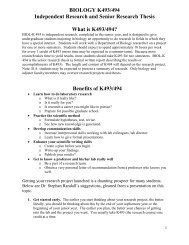

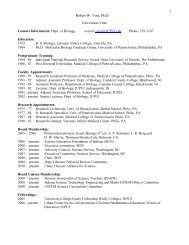
![Monoclonal antibody successes in the clinic [PDF] - Biology @ IUPUI](https://img.yumpu.com/30446580/1/190x249/monoclonal-antibody-successes-in-the-clinic-pdf-biology-iupui.jpg?quality=85)
